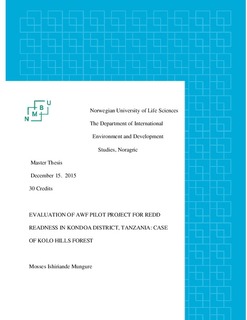| dc.description.abstract | The continuing loss of forest cover in developing countries, especially in the tropics has become an increasing concern to researchers and policy makers. This concern is a reasonable reflection of the multiple benefits of tropical forests, such as their support of human livelihoods, carbon sequestration, and biodiversity conservation. In addition to its immediate bearing on livelihoods, forests’ role in ecological services as through carbon sequestration has been of great interest. However, human activities like land conversion for agriculture, charcoal production, firewood collection, settlement expansions, excessive logging and wild fires posed a grim threat on forests’ abilities to sequestrate carbon. In responding to this, the United Nations Framework Convention on Climate Change (UNFCCC) prepared an action plan and road map which includes reduction of Green House Gases (GHGs) through an approach known as Reducing Emissions from Deforestation and Forest Degradation (REDD). Tanzania is one of nine pilot countries where UN assistance is channeled to test REDD interventions in nine (9) pilot sites as a recent policy response to halting global forest deforestation and degradation, and any resulting greenhouse gas emission which also includes the role of conservation, sustainable management and enhancement of forest carbon stocks. However, still at its infancy a number of challenges are associated with its implementation. Therefore, this study was conducted to assessment/Evaluation of the AWF Pilot Project for REDD Readiness in Kondoa District, Tanzania by taking a case of Kolo Hills forests. Specifically, the study had assessed local peoples’ awareness and perceptions about the intervention, as well as identified alternative sources of livelihoods for forest dependent communities and challenges in implementing the REDD+ initiative. A cross-sectional research design was adopted and a total of 150 respondents were involved from the opted-in and out implementing villages. Results have indicated that the majority of Kondoa residents were aware of the intervention while, majority had reported REDD+ implementing organization, African Wildlife Foundation (AWF) to be the source of their awareness of the project. A large share of the respondents expressed positive perceptions about REDD+ initiative, however, there were statistically significant differences (p<0.01) in perceptions between respondents from the two different villages. Agriculture, tree seedling production, mud bricks and stove making among others were identified as new livelihoods sources for the forest reliant communities in Kondoa, and among others, illegal forest harvests, low awareness among people as well as leakages was identified as potential threats for the REDD implementation. The study conclude that, REDD+ has a potential to become an appropriate mechanism to help reduce global Green House Gasses (GHGs) emissions and enhancing the livelihoods of forest dependent people if the mentioned challenges can be addressed. With such a large population depending on forest for subsistence livelihood in Kondoa, the study acclaimed that, strategies for controlling forest degradation need to be focused on reducing the dependence by creating alternative livelihood opportunities that will compete against the desires for forest use and degradation to the forest dependent communities, providing alternative technologies to reduce the gap in demand and supply of forest products and making the community adopt sustainable harvesting practices. | nb_NO |

